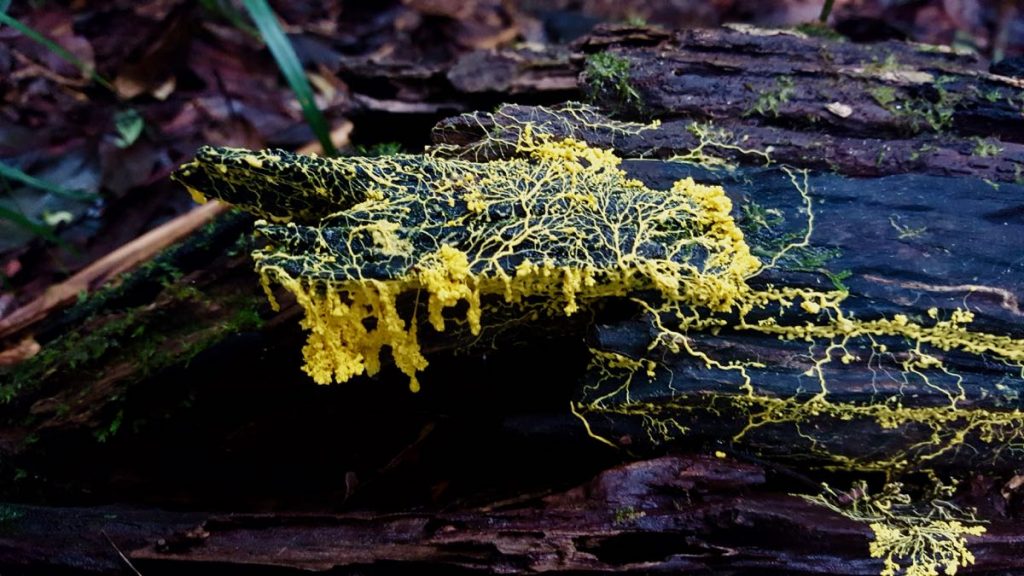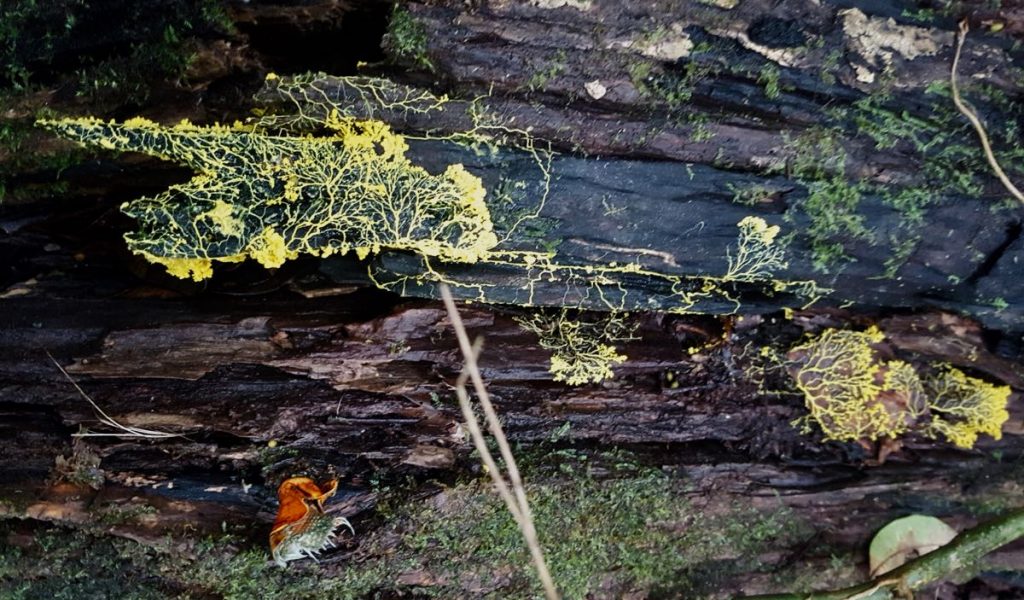On New Year’s morning, there were a few million animals hanging out together on a decaying log on the forest floor on ‘H Track’, doing their thing. This is a Slime Mould, and most likely to be Physarum polycephalum, the Many Headed Slime Mould, and some of the things they do are quite funky.

Slime moulds are thought to be approximately 600 million years old, although some think they could be as old as a billion. They arrived on land as soon as there was land, making them hundreds of millions of years older than other animals or plants. So, okay, they have been around for a long time, but what are they?
Slime moulds are Protists, or single celled organisms, which like moist, humid, dark environments, such as the rainforest floor. They favour rotting and decaying vegetation, where they feed on micro-organisms, including fungi, algae and bacteria. A single slime mould cell, in favourable conditions exists as an Amoeba, basically a nucleous surrounded by cell fluid, contained within a membrane. Amoeba travel by moving this fluid within the flexible cell membrane in a process known as cytoplasmic streaming, which is handy when you need to hunt down your prey, before engulfing it with your body. But what about when food is scarce, and too difficult to find when you’re a microscopic bag of fluid?
Slime moulds form a plasmodium, which is the part of the life cycle shown in the photo. Huge numbers of single celled amoebae find each other in the environment using chemical signals, and join together, losing individual cell membranes to form a complex organism. This organism is also able to move to search for food, which it surrounds, before secreting enzymes to digest it. This is also the primary reproductive stage for slime moulds; if food runs out, conditions become too dry or receive too much light, the plasmodium begins to make spores. This is the stage the photographs show, with the bumpy bits (the many heads of our slime mould) containing the spores.

The spores are able to survive unfavourable environmental conditions for long periods of time. When conditions improve, the spores rupture, producing a single cell amoeba. However, if things get too wet, this amoeba is able to rapidly transform into a flagellated organism (a flagellum is a long, whip-like structure which helps the animal move in water, similar to swimming). This shape is also reversible when conditions are not quite so wet, and being an amoeba is more convenient.
But you don’t get to be nearly a billion years old without having a few more tricks up your sleeve. If life becomes uncomfortable at the plasmodium stage, the organism can become dormant, and it can survive like this for many years. Amoeba can also transform into cysts to survive when conditions are unfavourable. It’s kind of like being able to go into suspended animation whenever it’s too hot, too dry or too bright. Amoeba can also fuse with other single amoeba to form a reproductive organism, or a single amoeba can reproduce by just splitting. Plasmodia can also fragment or enter another dormant phase called a spherule which can survive indefinitely. So, Slime Moulds have lots of options, including shape shifting, mind (and body) melding and suspended animation to enable them to survive in this unpredictable and changeable world. And that’s why they’ve been around so long!
These amazing creatures have fascinated scientists, and provided many opportunities for research. They are easy to culture in laboratories, and provide a model organism to study amoeboid movement, cell motility, and other anatomical and physiological processes. The real surprise however is that slime moulds also provide opportunity for behavioural research. They have been observed finding food in mazes and forming networks between food sources to provide efficient nutrient transport that rivals our own transport design systems. These adaptable and resilient organisms will probably be around for the next billion years!
Text & Photos by Sarah Swan

A very informative article, Sarah. There is also another species of slime mould that can often be found in garden mulch around Paluma Village. It is aptly called “dog vomit fungi” (Fuligo septica). It has the consistency of chocolate mousse and is orange to bright yellow in colour. I seem to have lost the photo of one that was in my garden last year but it looks very much like this image I have borrowed from the web.
A fascinating article about these extraordinary creatures. Thank you, Sarah.